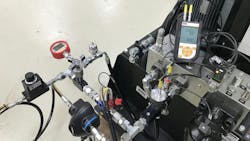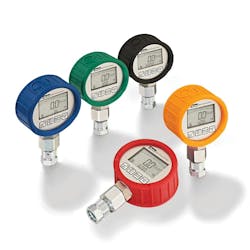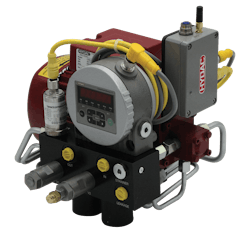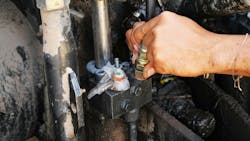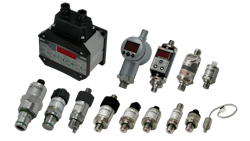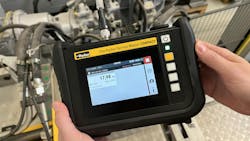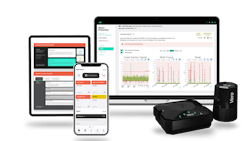Preventative and Predictive Maintenance in Fluid Power: The Technologies and Benefits
Proper maintenance of hydraulic and pneumatic systems is critical to ensuring long-lasting performance. Typically, maintenance practices over the years have been more reactive in that a problem is fixed only once it is detected.
With the reactive approach to maintenance, it is simple and intuitive — if a motor wears out, it gets replaced. There are low up-front costs because no sensors or networking capabilities are required. But when that motor does fail, hopefully a replacement is available otherwise production is held up for the machine and every worker who depends on it, said Connor Dudas, Application Engineer at Schroeder Industries, during a presentation given as part of the National Fluid Power Association’s (NFPA) March 2024 Quarterly Technology Conference.
If that motor is used in a CNC which makes manifolds, for example, he said all the parts assemblers that depend on production of the manifolds to complete their work are also impacted by the machine going down. “This reactive maintenance strategy has a costly, cascading effect,” he said.
Integrating sensors, telematics and other technologies into a machine and its fluid power systems to move toward more preventative and predictive maintenance enables machine owners to better determine when there is an issue and be more proactive about addressing it before downtime occurs.
Understanding the Differences Between Preventative and Predictive Maintenance
While the goals of preventative and predictive maintenance are similar, understanding how they differ can ensure deployment of the system which best meets the needs of end-use customers.
Preventative maintenance, also referred to as planned maintenance, uses historical data to estimate maintenance needs. Often, maintenance is scheduled for an optimal time to minimize costs, such as during a planned facility downtime.
However, there are disadvantages associated with this approach. Dudas said if you have a pump with a rated lifespan of 8,000 hours continuous duty, which is about 333 days, but conducting maintenance every quarter, you could be missing out on as much as 2 months of that component’s lifespan. “That’s roughly 20% of the estimated lifespan that you’re paying for but not able to use.”
Predictive maintenance, on the other hand, requires more data that is machine specific. This allows individual decisions to be made about an individual machine. It typically uses sensor technology and data analytics to monitor real-time asset condition, Dudas explained. “This is a further improvement upon preventative maintenance strategies,” he said.
There are upfront costs associated with predictive maintenance systems for the sensors and networking capabilities, but Dudas noted these have come down in recent years and most companies have the IT infrastructure in place already which also helps to reduce system costs.
And these costs are going to be lower in comparison to an unplanned downtime event that might otherwise occur. Downtime is directly responsible for unproduced goods, which means a company’s product is not getting into the market and creating revenue.
There are also costs associated with employee wages that still need to be paid during a downtime event, ordering of emergency spare parts, contractual obligations possibly not being met, as well as potential safety and legal issues.
Dudas cited data from a Siemens Senseye study which showed there has been a 50% rise in costs associated with unplanned downtime since 2019 for manufacturers in various industries, demonstrating the value preventative and predictive maintenance systems can bring.
Sensors Improve Failure Detection
The ideal scenario for any hydraulic or pneumatic component is to get as much life out of it as possible without experiencing downtime. Unfortunately, this will not always be the case.
Therefore, being able to detect potential downtime issues is beneficial to extending the useful life of components when feasible. Dudas said there are many indicators for machine quality and typically those which are most observable are those indicating impending failure. Here again he gave the example of a motor — if it is hot to the touch and noisy, those are easy to tell in person but also dangerous indicators of failure.
These types of indicators often show up moments before catastrophic failure “and the component has likely already lost significant efficiency by then,” he said.
However, there are places where predictive maintenance strategies can be implemented, typically for those aspects which are harder to observe. “We can use sensor technology to monitor things like vibration, fluid condition and thermography to help estimate remaining oil and component life,” said Dudas.
He said there are three main parts to predictive maintenance systems — sensor integration, gateways and IoT (Internet of Things), and analysis. Sensors used in these systems can come in many forms; those most applicable for the hydraulics industry include:
- particle
- saturation
- oil life
- temperature
- flow and pressure
- vibration.
By incorporating these sensors, it is possible to continuously monitor various performance aspects instead of relying on manual observations, which may not even be possible for some of these parameters.
From Schroeder Industries’ perspective as a developer of hydraulic filtration technology, fluid condition monitoring sensors (particle, saturation and oil life) are the most valuable and effective, said Dudas. “These sensors allow you to get to the root of the problem and make a meaningful, holistic solution.”
He said vibration sensors are valuable in that they can tell what pump is failing, but it can’t tell you why whereas fluid condition sensors can. For instance, if a particle sensor is reading higher than standard, it may be because a filter needs to be changed. With that information, machine owners can be proactive about replacing the filter to prevent downtime.
READ MORE: Sensors Improve Monitoring of Hydraulic Oil Conditions
Maintenance Technologies Need to Provide Valuable Information
Dudas said data without analysis is meaningless. “Sensors are necessary and useful, but only a small part of the [predictive maintenance] story.”
It is not feasible to hire people to monitor sensor data all day, which he said is where the second part of a predictive maintenance system comes in, the gateway devices and IoT. “These devices allow us to pull meaningful data from all of the sensors [and] analyze trends to predict failure,” he said. “We know the warning signs of machine failure in hydraulic systems — excessive heat, vibration, noise, decreased efficiency. All of these are useful and detectable symptoms of failure.”
He continued that gateway and IoT devices can help isolate meaningful data and communicate it to a centrally located system where it delivers the signs of failure and delegate maintenance tasks to address them. “Analysis without action is pointless,” said Dudas.
Understanding the need to provide actionable maintenance information, Parker Hannifin’s Quick Coupling Division developed its SensoControl measuring devices for mobile and industrial hydraulic systems. The portfolio includes sensors capable of measuring flow, temperature and pressure as well as handheld devices which read data from these sensors and provide information to diagnose potential maintenance issues.
Cameron Koller, Market Development Manager at Parker Hannifin’s Quick Coupling Division, said the technology is typically used when there is an indication of a problem to determine what it is and how to address it, enabling maintenance personnel to prevent further issues downstream. “You can get active measurements and record them in real time while [still safely] using a machine,” he said.
This enables machine owners to gather information and start diagnosing potential issues as soon as possible to mitigate larger and more costly downtime issues. The ability to provide rapid, accurate information on hydraulic system performance is an important part of SensoControl’s value proposition he said. “That allows [end users] to make much more informed decisions and define how they can solve the problem before it becomes a bigger problem.”
When it comes to maintenance tools, Koller said fluid power has historically been an antiquated market in terms of visibility to information and data. Many applications are in dirty environments and cost has been a factor as well, so adding preventative and predictive maintenance technologies to an operation requires a clear value proposition.
“At the end of the day the end customer has to use it, and it has to be meaningful for them,” he said.
His colleague Emily Santoni, Product Sales Manager at Parker Hannifin’s Quick Coupling Division, agrees that people need to see the value proposition of using preventative and predictive maintenance technology.
She offered the example of pressure spikes in a hydraulic system which can cause expensive downstream issues if not detected early. If a pressure spike occurs, it can lead to seal wash out which then negatively impacts the pump system and filters. “These can be very expensive, time consuming, [and] labor-intensive problems,” she said.
But by investing in maintenance tools, it is possible to identify these issues early and determine how to fix them. In addition, tools like SensoControl enable users to read and export data without being in the immediate vicinity of a machine, giving them “safer, faster, better information,” she said.
Santoni said speaking to the customer and making sure they understand the value of such products is important.
Machine Learning and AI Improving Analysis Capabilities
Data analysis has been a relatively manual process for many years. However, Dudas said implementing machine learning and artificial intelligence (AI) tools into maintenance systems can help improve analysis.
With these tools, it could be possible to reliably tell maintenance teams when it’s time to change a motor to get 90% of the lifespan out of it, he said. Automatically creating a schedule for when to replace components based on the urgency of doing so could also be possible.
In conjunction, purchasing teams can be notified when a hydraulic motor is at 50% of its lifespan so spare parts can be ordered in a timely manner. This also reduces the number of spare parts that need to be kept on hand and thus the costs associated with storing and ordering them.
“We see this could ultimately change the landscape of predictive maintenance,” he said.
To help its customers be more proactive with their maintenance, AssetWatch offers an oil analysis program in which dedicated engineers analyze data as soon as they receive it and provide feedback to customers on any issues they may detect. The company told Power & Motion it is able to compile this data, set thresholds and alarm limits, and contact customers immediately with the best recommendations or next steps if any of those are surpassed.
AssetWatch said it uses artificial intelligence (AI) and humans working together to find speedy and accurate resolutions for its customers. Its oil analysis program can be used to test for particle contamination, wear metals, viscosity, acid, water and more, all of which can negatively impact the performance of a hydraulic system. The company noted its oil analysis capabilities can be combined with its Vero continuous monitoring technology which sends vibration and temperature data for further performance information to aid maintenance, and that the technology can be used with both hydraulic and pneumatic systems.
Use of machine learning and AI will help to create more digital, easy-to-use interfaces which Koller and Santoni noted preventative and predictive maintenance technologies are moving toward. This will help to provide a better value proposition for end users by making information easy to collect and interpret, enabling them to quickly address maintenance issues.
As the fluid power industry and its customer markets continue to experience a generational shift in which personnel with years of experience are retiring and the younger generations coming in do not yet have that industry knowledge, tools capable of helping to easily detect and address maintenance issues will be critical.
About the Author
Sara Jensen
Executive Editor, Power & Motion
Sara Jensen is executive editor of Power & Motion, directing expanded coverage into the modern fluid power space, as well as mechatronic and smart technologies. She has over 15 years of publishing experience. Prior to Power & Motion she spent 11 years with a trade publication for engineers of heavy-duty equipment, the last 3 of which were as the editor and brand lead. Over the course of her time in the B2B industry, Sara has gained an extensive knowledge of various heavy-duty equipment industries — including construction, agriculture, mining and on-road trucks —along with the systems and market trends which impact them such as fluid power and electronic motion control technologies.
You can follow Sara and Power & Motion via the following social media handles:
X (formerly Twitter): @TechnlgyEditor and @PowerMotionTech
LinkedIn: @SaraJensen and @Power&Motion
Facebook: @PowerMotionTech

Leaders relevant to this article:
